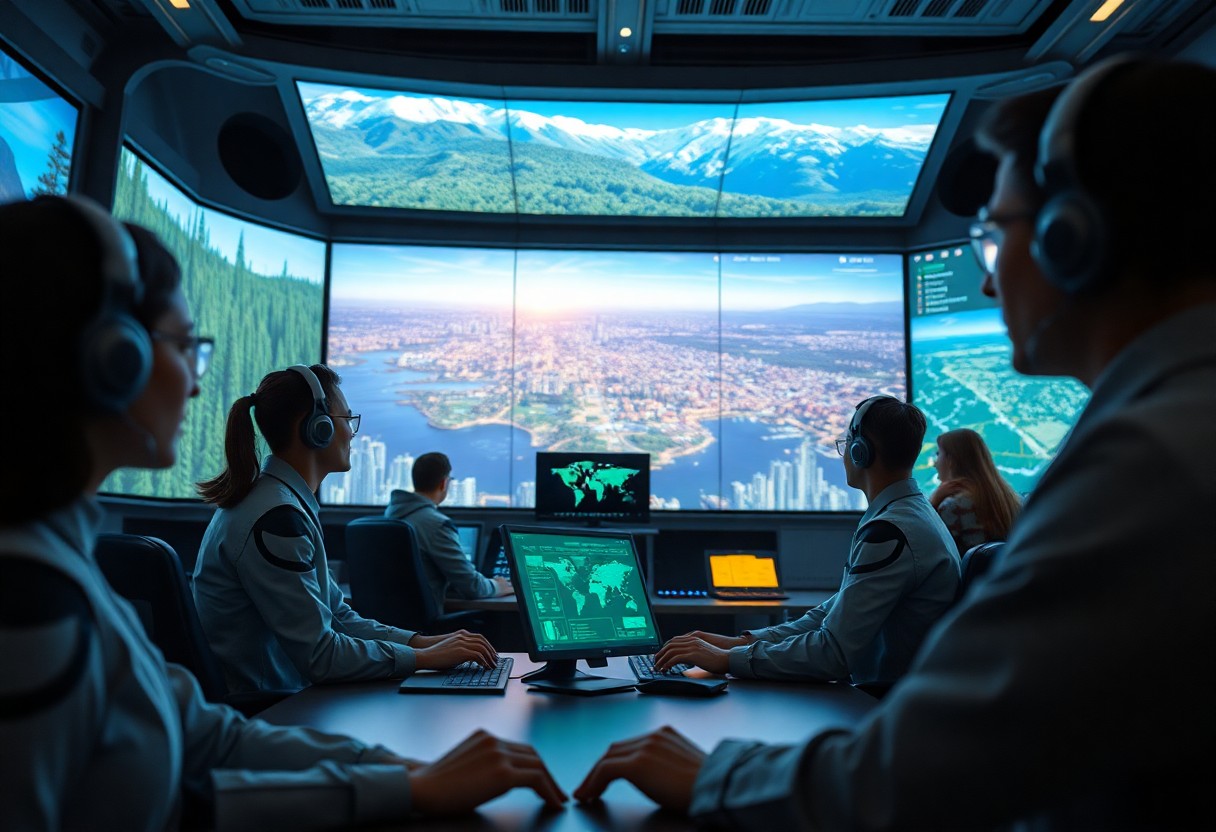Key Takeaways:
- Artificial Intelligence (AI) agents play a significant role in managing Environmental Risk by analyzing large amounts of Data to predict and prevent Natural Disasters such as hurricanes, wildfires, and floods.
- AI agents can help identify High-Risk Areas and provide Real-Time Monitoring of environmental conditions, enabling Swift Action to be taken to mitigate the impact of Climate Change.
- The use of AI agents in Environmental Management can also help optimize Resource Allocation and Decision-Making processes, leading to more Effective and Sustainable management of Environmental Resources.
Role of AI in Environmental Risk Management
To effectively manage environmental risk, you can leverage AI agents, as seen when Exploring AI Agent Environments: How They Shape Your Understanding of the impact on ecosystems. This allows you to make informed decisions.
Identifying Potential Risks
To tackle environmental challenges, you must first identify potential risks, analyzing data to pinpoint vulnerabilities in your ecosystem, enabling you to take proactive measures.
Predictive Analytics
Potentially, one of the most significant benefits of AI in environmental risk management is its ability to forecast future threats, helping you prepare and mitigate damage.
Indeed, predictive analytics enables you to analyze historical data, identify patterns, and forecast potential environmental hazards, allowing you to develop strategies to minimize their impact on your ecosystem, ultimately protecting your environment and assets.
Applications of AI in Environmental Monitoring
While exploring the potential of AI in managing environmental risk, you will discover its significant role in monitoring various aspects of the environment. AI agents can analyze vast amounts of data to identify patterns and trends, enabling you to make informed decisions about your environmental strategies.
Air and Water Quality Monitoring
Prior to implementing AI solutions, you may have relied on manual methods to monitor air and water quality, but now you can leverage AI-powered sensors to detect pollutants and track changes in environmental conditions, allowing you to take proactive measures to mitigate their impact.
Land Use and Deforestation Tracking
Observing changes in land use and deforestation, you can utilize AI-driven satellite imagery to monitor forest cover, track land degradation, and identify areas at risk, enabling you to develop effective conservation strategies to protect your environment.
Also, as you explore deeper into land use and deforestation tracking, you will find that AI algorithms can help you analyze complex data sets, including geographic information systems (GIS) and remote sensing data, to understand the drivers of deforestation and land degradation, and develop targeted interventions to address these issues, ultimately helping you to make a positive impact on your environment.
AI-powered Decision Support Systems
After implementing AI-powered decision support systems, you can analyze environmental risks more effectively. These systems provide you with data-driven insights, enabling you to make informed decisions and mitigate potential risks.
Data-driven Policy Making
Prior to developing policies, you consider the data and analytics provided by AI agents, allowing you to create more effective and targeted environmental policies that address your specific needs.
Emergency Response Planning
Approximately at the same time you are facing an environmental disaster, AI agents can help you develop emergency response plans, providing you with the necessary tools to respond quickly and efficiently.
Making the most of AI agents in emergency response planning, you can simulate different scenarios, anticipating and preparing for potential risks, and developing strategies to minimize damage to the environment and your community, ultimately helping you to respond more effectively in the face of disaster.
Benefits of AI-driven Environmental Management
Despite the complexity of environmental management, AI agents can help you streamline your processes and reduce risks. By leveraging AI, you can make more informed decisions and improve your overall environmental management strategy.
Improved Accuracy and Efficiency
Benefits of AI-driven environmental management include increased accuracy and efficiency in data collection and analysis, allowing you to identify potential risks and take proactive measures to mitigate them.
Enhanced Collaboration and Coordination
Beneath the surface of AI-driven environmental management lies the potential for enhanced collaboration and coordination among stakeholders, enabling you to work more effectively with your team and partners to address environmental concerns.
Due to the ability of AI agents to facilitate seamless communication and data sharing, you can expect to see improved collaboration and coordination among your team members, stakeholders, and regulatory agencies, ultimately leading to more effective environmental management and reduced risks for your organization.

Challenges and Limitations of AI in Environmental Risk Management
All efforts to implement AI agents in environmental risk management are hindered by several challenges, as you can learn more about in AI Agents: How AI will Engage with Its Environment. You will encounter obstacles that need to be addressed for successful implementation.
Data Quality and Availability
Around the issues of data, you will find that high-quality data is important for AI agents to function effectively, yet it is often scarce or unreliable, impacting your ability to make informed decisions.
Integration with Existing Systems
Among the technical challenges, integrating AI agents with your existing systems can be particularly daunting, as it requires significant updates to your infrastructure and compatibility with various software and hardware components.
Limitations in integrating AI with your existing systems can lead to inefficiencies and increased costs, making it important for you to carefully plan and execute the integration process to ensure seamless interaction between AI agents and your current infrastructure, ultimately affecting your overall environmental risk management strategy.
Future Directions for AI in Environmental Risk Management
For the effective management of environmental risks, you will need to consider the evolving role of AI agents in this field, as they continue to advance and improve in their capabilities, enabling you to make more informed decisions about your environmental risk management strategies.
Emerging Trends and Technologies
Across various industries, you are seeing the development of new AI-powered tools and technologies that can help you better manage environmental risks, from predictive analytics to machine learning algorithms, all of which can be leveraged to enhance your environmental risk management practices.
Potential Applications and Opportunities
Emerging areas of application for AI in environmental risk management include climate change modeling, natural disaster prediction, and sustainability monitoring, all of which can help you identify and mitigate potential environmental risks more effectively, and make more strategic decisions about your operations and investments.
Trends in AI development suggest that you will have access to even more sophisticated tools and technologies in the future, enabling you to simulate various scenarios, forecast potential outcomes, and develop more effective strategies for managing environmental risks, ultimately helping you to minimize your environmental footprint and ensure a more sustainable future for your organization.
Final Words
Following this exploration of AI agents in environmental risk management, you now understand how they enhance your ability to predict and mitigate threats. You can leverage AI to analyze data, identify patterns, and make informed decisions to protect your environment. By utilizing AI agents, you optimize your strategies and minimize risks, ultimately contributing to a more sustainable future for your community and your planet.
FAQ
Q: What role do AI agents play in managing environmental risk?
A: AI agents play a significant role in managing environmental risk by analyzing large amounts of data from various sources, including sensors, drones, and satellites, to identify potential risks and predict environmental disasters such as wildfires, floods, and hurricanes. They can also help monitor and track changes in environmental conditions, providing real-time insights to support decision-making and mitigation efforts.
Q: How do AI agents help in monitoring and predicting environmental disasters?
A: AI agents utilize machine learning algorithms to analyze historical data and real-time inputs from various sources to predict the likelihood and potential impact of environmental disasters. For instance, they can analyze satellite images to detect early signs of wildfires or use sensor data to predict water levels and warn of potential floods. This enables authorities to take proactive measures to mitigate the effects of these disasters and protect both the environment and human populations.
Q: Can AI agents assist in the assessment of environmental damage after a disaster?
A: Yes, AI agents can significantly assist in the assessment of environmental damage after a disaster. By analyzing data from drones, satellites, and other sources, AI can help map the extent of the damage, identify areas of highest priority for cleanup and restoration, and even assess the impact on local wildlife and ecosystems. This information is vital for planning effective relief and restoration efforts, ensuring that resources are allocated efficiently and that the recovery process is as swift and effective as possible.
Q: How do AI agents contribute to sustainable practices and environmental conservation?
A: AI agents contribute to sustainable practices and environmental conservation by optimizing resource usage, reducing waste, and promoting eco-friendly behaviors. For example, AI can optimize energy consumption in buildings and industries, predict and manage water supply demands, and even help in designing more sustainable supply chains. Additionally, AI-driven analytics can provide insights into consumer behavior, helping to develop targeted campaigns that promote environmental awareness and sustainable living practices.
Q: What is the future potential of AI agents in environmental risk management?
A: The future potential of AI agents in environmental risk management is vast and promising. As AI technology continues to evolve, it is expected to play an increasingly central role in predicting, preventing, and mitigating environmental disasters. Future developments may include more sophisticated early warning systems, enhanced precision in predicting environmental changes, and more effective tools for monitoring and preserving biodiversity. Moreover, the integration of AI with other technologies like IoT and blockchain could lead to more comprehensive and sustainable environmental management systems, ultimately contributing to a safer and healthier planet for future generations.


